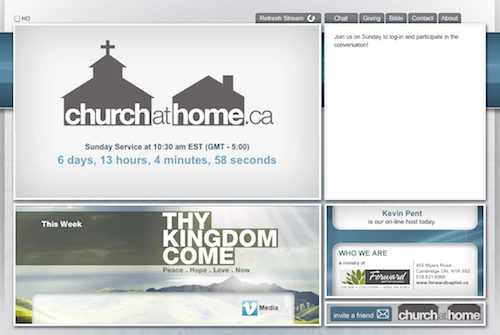Church At Home is a somewhat new ministry of our home church here in Ontario. The leadership’s vision was to allow those who might not be comfortable coming into a big church for the first time to check it out and see that its not that weird or scary, and to facilitate community and connection with our global church family. We do this with a live video stream and a facilitated chat window where people can discuss the service. Notes and supporting media are posted as they’re available as well.
This has been a long project for me, that started as a quick and dirty proof of concept that too rapidly became a production system — followed by months of hunting down and squashing bugs. We basically ripped and replaced every major component of the original system, including a nearly complete re-write of the website back-end, a reinvented chat system, a new Internet connection, a new streaming computer, a new CDN service, and finally a new stream publishing system.
For publishing the stream, we started with Expression Encoder Pro, which for reasons related to my employer I was obviously biased towards. It was installed on a Mac Mini running Windows 7, but we quickly determined that the little Mac was underpowered. That was replaced by a Lenovo desktop with an Core i3 processor. We recently added a second Lenovo machine with a Core i5 that will run the HD stream.
At first we pushed the stream to a blade server running at a local ISP who was willing to donate bandwidth, but we had problems and were concerned about scaling, so we connected with FaithNetwork, who set us up on the Edgecast CDN.
Rogers Cable Internet was unable to provide a guaranteed upload bandwidth, so after more problems, we went with an MLPPP connection. Its theoretically better, but the customer service is even worse, so I’m not going to advertise that provider.
Expression has a known issue with ending the stream when connectivity drops — even for a fraction of a second, so although Silverlight SmoothStreaming gave us some amazing capabilities (allowing us to publish multiple stream qualities AND deliver iOS support, all from the same computer!) we were forced to switch to Flash Media Encoder, which is frankly better known and supported by EdgeCast. This is unfortunate because Flash needs to die, but for the sake of our volunteers, and because we’re using essentially a residential Internet connection, we had to make the switch.
A number of skilled individuals participated in the project, wiring up the necessary equipment, coding the website (including handling issues with multiple timezones and shifting streaming technologies), and navigating the personalities involved in setting this up. Eric provided leadership and oversight, and his company LucidMedia created many of the pieces, Pat made the website work, and Verne connected the systems.
As of today, we think I finally have a system that is reliable, easy to consume, and easy for volunteers to operate. You can start it up (from powered down!) in 6 clicks, and shut it down in the same amount. If you don’t go to church, or haven’t been in awhile, you should check it out. I’m proud that my church has some enjoyable, meaningful music, and straight, honest and challenging teaching.
I’m declaring this project done — a multi-site launch is the next ministry project we’re helping out with, along with some old friends and new ones, and I’m sure it will be even more fun than the last time we did one of these!

SDG




One thought on “Church At Home out of Beta”